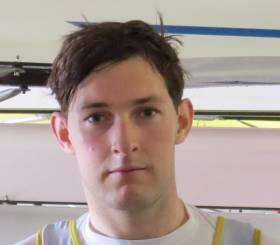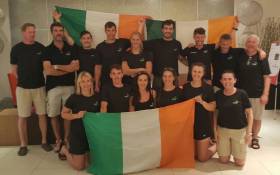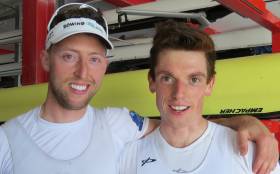Displaying items by tag: Shane O'Driscoll
North Island Final A Heavyweight Test for Paul O'Donovan
#Rowing: Paul O’Donovan finished sixth of the eight competitors who reached the A Final of the Premier Single Sculls at the North Island Club Rowing Championships in New Zealand. Robbie Manson, the top heavyweight single sculler won. Gary O’Donovan took third place in the B Final.
Mark O’Donovan and Shane O’Driscoll won their B Final of the Premier Pair, taking ninth overall. Max Murphy, the former UCD captain, was part of the Waikato senior pair which finished fourth in their final.
North Island Rowing Championships, Lake Karapiro, New Zealand (Irish interest)
Men
Premier Pair – B Final: 1 Skibbereen (M O’Donovan, S O’Driscoll) 6:43.34.
Senior Pair – Final: 4 Waikato (M Murphy, T Bedford) 6:51.51.
Premier Single – A Final: 1 R Manson 6:39.58; 6 Skibbereen (P O’Donovan) 6:54.63. B Final: 3 Skibbereen (G O’Donovan) 6:57.21.
First Outing for O'Driscoll and O'Donovan as Heavyweights in New Zealand
#Rowing: Mark O’Donovan and Shane O’Driscoll competed as a heavyweight pair at the North Island Championships in New Zealand today. The world champions in the lightweight pair, who have switched to heavyweight in the hope of competing at the 2020 Olympic Games in Tokyo, finished fourth in their heat.
Paul O’Donovan and Gary O’Donovan both finished sixth in their heats of the single sculls. Both also competed as heavyweights.
All three boats move into repechages on Sunday.
O'Driscoll and O'Donovan are Afloat Rowers of the Year
#Rowers of the Year: The Afloat Rowers of the Year for 2017 are Shane O’Driscoll and Mark O’Donovan. The two formed the Ireland lightweight pair which won European and World Championship gold. They also won gold in each of the three World Cup regattas, in Belgrade, Poznan and Lucerne. Their glorious run was the pay-off for enormous amounts of work – and a drive which came from their determination to make their mark after coming up short the in 2016, when they finished fourth at the World Championships.
The two have opted to move up to heavyweight with the aim of competing at the Olympic Games in Tokyo in 2020. Afloat wishes them every success.
Afloat Rower of the Month awards: The judging panel is made up of Liam Gorman, rowing correspondent of The Irish Times, and David O'Brien, editor of Afloat magazine. Monthly awards for achievements during the year appeared on afloat.ie.
World Champion Rowers Nominated for Team of the Year
#Rowing: Shane O’Driscoll and Mark O’Donovan have been nominated for the Team of the Year at the RTÉ Sports Awards for 2017. The world champions in the lightweight pair could take over from Paul O’Donovan and Gary O’Donovan, who won in 2016. The awards will be presented on Saturday, December 16th. The public can vote on the night.
Heavy Challenge for Ireland's Golden Rowers
#Rowing: Mark O’Donovan and Shane O’Driscoll, the world champions in the lightweight pair, have decided to go heavyweight. “We have to do this. We want to go to an Olympics and this is the best way of going," O’Driscoll told The Southern Star.
Only one lightweight boat, the lightweight double, is an Olympic discipline. Paul and Gary O’Donovan took silver at the Olympic Games in Rio de Janeiro in 2016. They recently showed good form at the Ireland trial.
Shane O’Driscoll and Mark O’Donovan have been bulking up and O’Driscoll said they were ready to take on this “new chapter” in their competitive lives. “Before we raced the World Championships we had decided to go heavyweight,” he said. “We had one regatta left before we made that decision and we really wanted to win that World Championship.”
O'Driscoll and O'Donovan Honoured at Prestigious Awards Ceremony
#Rowing: Shane O’Driscoll and Mark O'Donovan have been honoured at the Irish Youth Foundation Excellence in Sport Awards. The world champions in the lightweight pair received their awards at the charity event hosted by golfer Padraig Harrington on Monday night in Dublin.
Other recipients included rugby great Paul O’Connell, European gold medal winning sprinter Gina Akpe-Moses, father-and-son horse racing duo Aidan O’Brien and Joseph O’Brien, World Rugby Referee of the Year Joy Neville and Olympic boxer Michael Carruth.
Lions rugby coach, Warren Gatland, the Dublin Gaelic football team and the Irish Show Jumping Team were also honoured.
“This is the first national recognition award we’ve received since the World Championships and it means an awful lot to us,” O’Driscoll said. “It’s nice to reflect on your achievements and we’re delighted to be recognised. It will keep us going for a while, now that we’re back into the hard slog of winter training.
“It’s also nice to have rowing recognised, because it’s such a great sport. You can take it up at any age and it’s such good fun. Anyone, young or old, can jump in a boat!” he said.
The rowing stars were interviewed on stage at the ceremony by RTÉ sports presenter Joanne Cantwell, who asked what they had done differently this year to achieve their world level success.
“We had a bit more belief in ourselves and to put it simply, we didn’t want to come fourth again. We wanted to win a medal at every regatta,” O’Driscoll said.
“We focused on overcoming our doubts and giving it everything because there’s no point in going out there if you think you can’t do it or you’re not 100 per cent committed and I think that’s something all the sports people in the audience could identify with.”
Speaking about sharing the stage with other sports stars, the Skibbereen oarsman said: “It was great to be up there with people like Paul O’Connell. He’s a living legend and when he stood up to speak, the whole room just went quiet. He was a very inspirational speaker and he talked about the fact that since he’s retired, he only remembers good things about his sports career, even though he probably found it all very challenging at the time. So it was great to hear insights like that.”
O’Driscoll said that he and O’Donovan were honoured to receive the award from such a worthwhile organisation.
“We got a real insight into the work of the Irish Youth Foundation at the awards and when you hear about the hardship some young people experience, it’s shocking. It makes you feel so privileged and I’m glad that sport can be a positive outlet for so many young people.”
All proceeds from the black tie fundraising event go toward the Irish Youth Foundation’s work with children and young people living in disadvantaged circumstances. The charity works primarily in the areas of homelessness, after-school education, primary-to-secondary school transition and skills and employability. Last year the Excellence in Sport Awards raised over €100,000.
Good Placing for Ireland Internationals in London Fours Head
#Rowing: A quadruple featuring three Ireland lightweight internationals finished 15th at the Head of the River Fours in London. Gary O’Donovan, Shane O’Driscoll and Mark O’Donovan joined Niall Kenny in the Tideway Scullers’ crew. They had serious equipment problems which affected their steering from early in the race.
Head of the River Fours, London (Irish interest): 15 Tideway Scullers’ School E 20 52.2
World Rowing Gold Medallists Return
#Rowing: Ireland gold medallists Paul O’Donovan, Shane O’Driscoll and Mark O’Donovan arrived back in Ireland today from the World Rowing Championships in Florida. They flew from Orlando to Dublin where family and friends greeted them. They were accompanied by Gary O’Donovan, an Olympic medallist in 2016 and reserve for the World Championships team. This evening they will be honoured at a reception in Skibbereen.
Ireland Team the Afloat Rowers of the Month for September
#Rowing: The Ireland team which brought the country glory at the World Rowing Championships in Florida are the Afloat Rowers of the Month for September. In that month, Ireland took two gold medals through Mark O’Donovan and Shane O’Driscoll in the lightweight pair and Paul O’Donovan in the lightweight single sculls.
The pair crowned the perfect season with their victory. They won gold at the three World Cup regattas and the European Championships. The pressure was on in World Championship final, with both Brazil and Italy rowing well on the day. But O’Donovan and O’Driscoll were peerless. They set a very high stroke rate, took the lead – and saw off their challengers.
Paul O’Donovan retained the title he had taken with such an extraordinary set of performances in Rotterdam in 2016, just weeks after he had taken a silver at the Olympic Games in a lightweight double with his brother Gary. This time, Gary had to drop out of the lightweight double, as illness had restricted his training (he supported the team as a reserve). Paul was back in the lightweight single in a boat which was new to him. He won all four races (heat, quarter-final, semi-final and final), seeing off a new set of challengers in the lightweight single, including Matthew Dunham of New Zealand, who took silver, and Kris Brun of Norway (bronze).
The rest of the Ireland team also gave the suppporters plenty to shout about. Sanita Puspure went on to take fourth in the single sculls and Denise Walsh reached the A Final of the lightweight single sculls, where she finished sixth. Two new heavyweight pairs gained experience of the top level as the team targets Tokyo 2020. Aileen Crowley and Aifric Keogh finished eighth and there was a 16th place for Patrick Boomer and Fionnán McQuillan-Tolan.
Well done to all the members of the Ireland team, the Afloat Rowers of the Month for September.
Rower of the Month awards: The judging panel is made up of Liam Gorman, rowing correspondent of The Irish Times, and David O'Brien, editor of Afloat magazine. Monthly awards for achievements during the year will appear on afloat.ie. Keep a monthly eye on progress and watch our 2017 champions list grow.
O'Driscoll and O'Donovan Win Way to A Final at World Championships
#Rowing: Mark O’Donovan and Shane O’Driscoll won their heat to qualify directly for the A Final of the lightweight pair at the World Rowing Championships.
Italy took an early lead, but Ireland took over in the second quarter. Britain challenged but O’Donovan and O’Driscoll won by over five seconds.
World Rowing Championships, Sarasota-Bradenton, Florida – Day One – Irish Interest:
Men
Lightweight Pair – Heat One (First to A Final; rest to Repechage): 1 Ireland (M O’Donovan, S O’Driscoll) 6:33.20, 2 Britain (J Cassells, S Scrimgeour) 6:38.57, 3 Italy 6:40.39.

































































